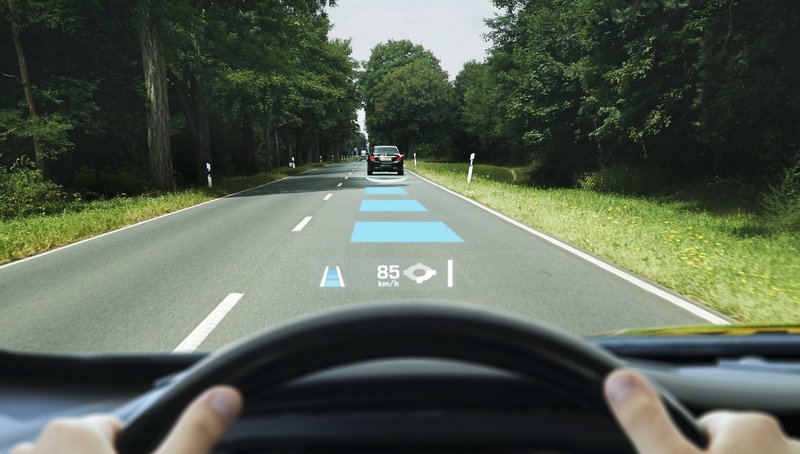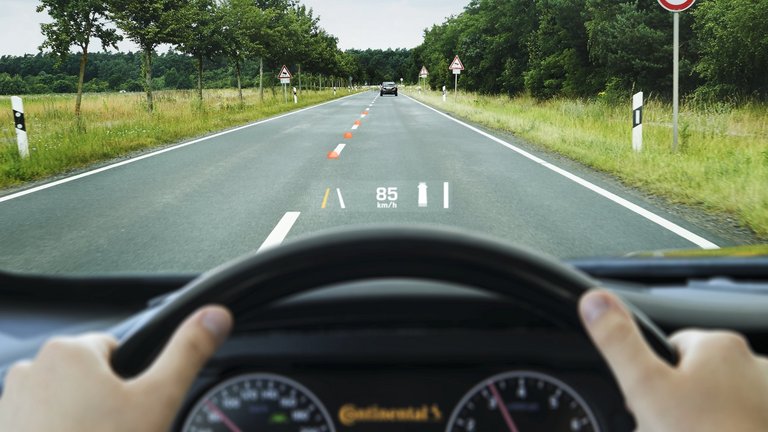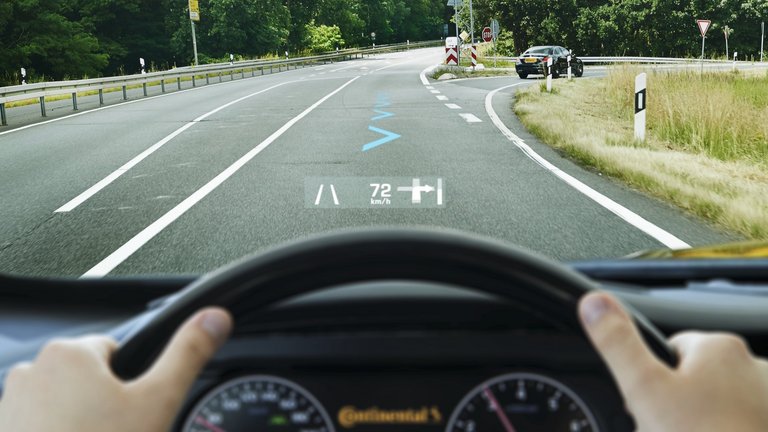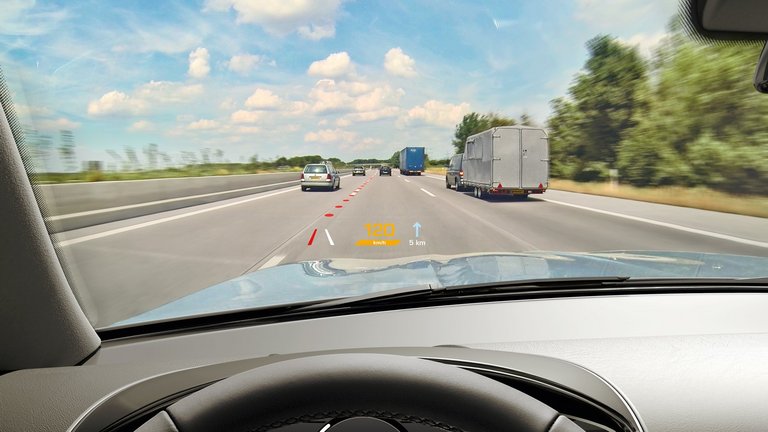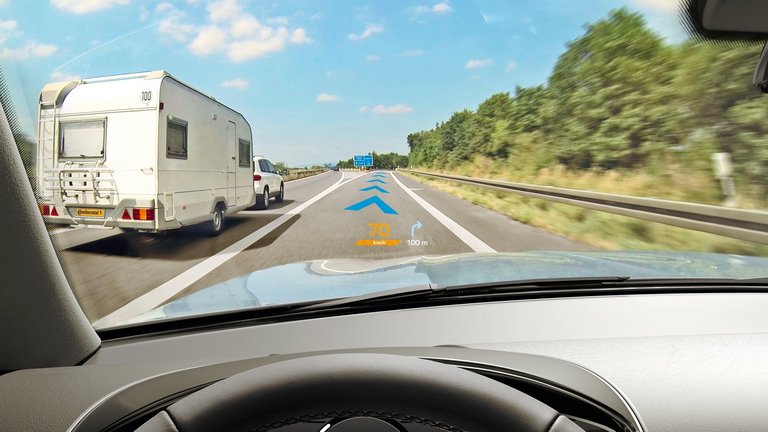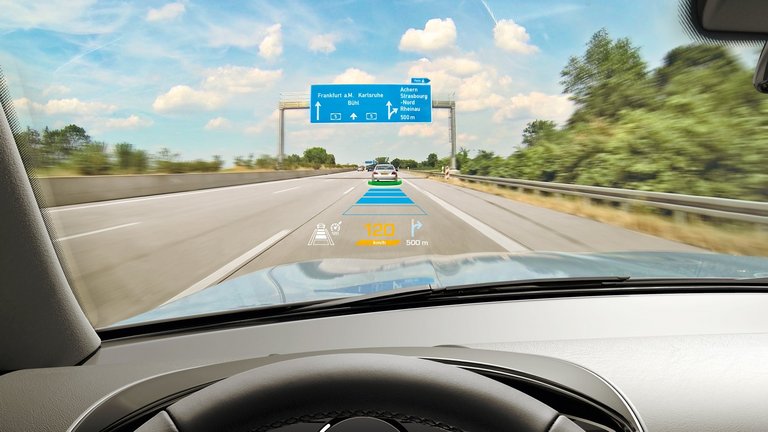Further Than the Eye Can See
- AR-HUD brings a new level of quality to holistic human machine interface in vehicles
- View of the road and the extended horizon of a vehicle will blend into one in the future
- Automated driving and AR-HUD are an ideal combination
Babenhausen/Germany, July, 21, 2014. The "Augmented Reality Head-up Display" (AR-HUD) was recently presented by the international automotive supplier Continental in its demo vehicle. This new development has the ability to revolutionize the car cockpit. In addition to "showing" the driver possible dangers, the car also "helps" them in an entirely new way: navigating through traffic. With virtual information (augmentations) embedded in the real exterior view, drivers intuitively recognize the significance of what they see in front of them. This takes the role of the AR-HUD far beyond that of the current head-up display. It will play an important part in future human machine interfaces (HMIs).
"In its current version, an HUD is an outstanding information filter. It moves a minimal amount of carefully selected information into the driver's line of vision," said Guido Meier-Arendt, the leading HMI expert in the Continental Interior division. "In demanding traffic situations, this frees drivers from frequently having to look down to their instrument cluster or center stack. They can pay constant attention to the traffic. We are retaining the HUD's proven philosophy of only displaying certain information; however, the information quality is far higher."
Three applications are implemented in the AR-HUD demo vehicle as examples: Lane Departure Warning (LDW), Adaptive Cruise Control (ACC), and navigation. The information relating to each application is reflected precisely into the road layout, supplementing reality with comments and information. This is a revolution in itself, but also just the beginning of a new kind of interaction with drivers.
The AR-HUD's role in the holistic HMI
"It doesn't render the instrument cluster superfluous in any way," said Meier-Arendt. "The cluster is still necessary as it continues to provide the most important overview of all vehicle functions. Ergonomically speaking, it would be unrealistic to constantly reflect such a wealth of information onto the windshield and cover the exterior view. The instrument cluster is still the best place for this information. However, the increasing requirements for the HMI in the car do require an extension."
Continental has long been working on further developing of the HMI so that it can face the challenges of many current trends while complying with traffic regulations. Challenges such as entertainment, electronics, and the Internet finding their way into the car; and the resulting change in user expectations, increasingly sensor-based driver assistance systems that need an interface with the driver; the growing volume of traffic and need for information about traffic jams and alternative options; expanding electromobility and its very specific need for information; and finally, automated driving, which introduces completely new requirements for the HMI. To enable the driver to control all of these options and functions, it is no longer sufficient to strictly assign each individual function to a display.
"Such rigid 1:1 references vanish in a holistic HMI. Instead, the traffic and the condition of the driver decide when and where it is best to process which information," explained Meier-Arendt. "The AR-HUD is a new model of a holistic HMI, and it is more capable than any other element in directing the driver's attention to where it should be: on the surrounding traffic."
Augmentation options with eHorizon
The AR-HUD in the Continental demo vehicle supplements reality with graphical information inserted precisely into the real exterior view. That is, so to speak, the "pure teaching" of the augmentation: seamlessly blending information and reality with precisely the correct perspective. However, there are driving situations where it can make sense to deviate from this model. For example, if a vehicle has an electronic horizon (eHorizon) then information that goes beyond the driver's field of vision can also be reflected in the AR-HUD. If the vehicle is approaching an intersection with a stop sign, which is positioned after a bend, this can be shown to the driver earlier . "However, it is by no means just a question of safety. The environment also benefits from drivers easing off the gas at the right time" stated Meier-Arendt.
The eHorizon uses knowledge about the current vehicle position. Information about the road ahead and its topography is processed within important control units, such as the engine control and transmission control units, and in driver assistance systems to optimize their respective function. The AR-HUD now offers the option to "tell" drivers in the correct visual context what their vehicle can "do" for them, or what it "recommends." "You get a good idea of what's going on from these messages," says Meier-Arendt. "The vehicle transforms into a coach and digital companion that interacts with the driver and supports them according to the situation."
Automated driving and AR-HUD
This new coach also plays a role in the worldwide trend for automated driving. Although automated driving provides comfort and convenience to the driver, it also brings new tasks into the car. As soon as the driver has given longitudinal and lateral control to their vehicle for a particular driving maneuver or a section of road, they go from a "doer" to a "supervisor." This changes their need for information. Drivers will want to know which vehicles, objects, and/or road markings their vehicle actually "sees." This is a significant way for the driver to develop trust in innovative vehicle functions. "We believe there is no better option for this than the AR-HUD. Here, the driver sees which vehicle in front is detected by their vehicle system. This direct visual confirmation is important feedback," explained Meier-Arendt.
The reverse situation is just as important. If a period of automated driving is coming to an end, then the driver has to take vehicle control back again. To do this, they must return to the "doer" role and determine the traffic situation so that they know how to safely proceed. "The AR-HUD is an ergonomically important procedure here too, for showing the driver what is expected of them in the correct context," is the conclusion of Meier-Arendt.
